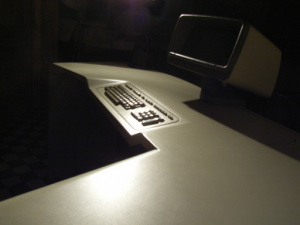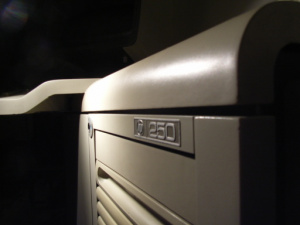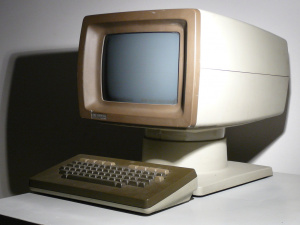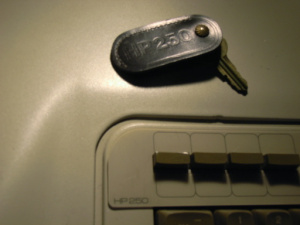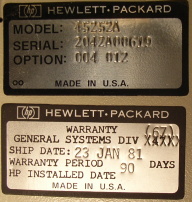Difference between revisions of "HP250"
(→Notes) |
|||
| (30 intermediate revisions by 3 users not shown) | |||
| Line 1: | Line 1: | ||
| + | [[File:RIMG3009b.JPG|thumb|]] | ||
| − | + | == Specification == | |
| − | * 256K RAM | + | |
| − | * Internal 8" drive | + | [[File:RIMG2999b.JPG|thumb|]] |
| − | * External | + | |
| − | * 2631B Line printer | + | * [http://www.hpmuseum.net/display_item.php?hw=249 Hewlett-Packard model 45252A (HP-250)] option 004,012 serial 2042A00619 |
| + | ** 256K RAM | ||
| + | ** Internal 9895K (8" floppy drive) | ||
| + | * External 9133XV (3,5" floppy + 14,5 MB hard disc) serial 2333A27570 | ||
| + | * [http://www.hpmuseum.net/display_item.php?hw=316 2631B Line printer] | ||
| + | * [http://www.hpmuseum.net/display_item.php?hw=242 2621B Terminal] | ||
| + | |||
| + | == Origin == | ||
| + | |||
| + | [[File:P1010822.resized.JPG|thumb|]] | ||
| + | |||
| + | * Acquired in 1991. The seller only asked the price of the extra HP-IB cable he bought for it. He presumably got it for free from the original owner (an insurance agency). | ||
== Condition == | == Condition == | ||
| − | * Generally works, boots | + | * Generally works, boots and can print. |
| − | * Monitor has mold spots under the front glass | + | * Monitor has mold spots under the front glass. This looks ugly and makes text hard to read. |
| − | * | + | * The 2621B terminal came with the system but cannot be connected (no serial ports). The terminal originally worked but broke down in the mid 1990's. |
| − | * | + | * The 9133 hard disc used to work but broke down in 2010 with a grinding noise. |
| − | |||
== To Do == | == To Do == | ||
* Fix the mold spots. This is a known problem and has been discussed on the [http://www.classiccmp.org/pipermail/cctech/ cctech] mailing list. E.g. [http://www.classiccmp.org/mailman/htdig/cctech/2003-October/021274.html here] and [http://www.classiccmp.org/mailman/htdig/cctech/2008-July/095509.html here]. | * Fix the mold spots. This is a known problem and has been discussed on the [http://www.classiccmp.org/pipermail/cctech/ cctech] mailing list. E.g. [http://www.classiccmp.org/mailman/htdig/cctech/2003-October/021274.html here] and [http://www.classiccmp.org/mailman/htdig/cctech/2008-July/095509.html here]. | ||
| + | * Restore the backup files from the discs that came from the original owner. I don't know what's in there. You need to know the protection code but there should be a way to circumvent that. | ||
| + | * Send a (bug) report to Ansgar Kückes (the author of the HPDir project) detailing my experiences on using his tools with a 250. | ||
| + | * Attempt to fix the 2621B terminal. | ||
| + | |||
| + | [[File:RIMG2990b.JPG|thumb|]] | ||
| + | |||
| + | == Usage Hints == | ||
| + | |||
| + | Use the reset button on the processor board instead of power cycling. | ||
| + | |||
| + | To boot from emulated 7910, set the thumbwheel on the processor board to 3, instead of 2 for booting from floppy. | ||
| + | |||
| + | |||
| + | == Data Exchange == | ||
| + | |||
| + | I used [http://www.hp9845.net/9845/projects/hpdrive/ HP Drive] to exchange software between the 250 and the outside world. | ||
| + | |||
| + | For this I used a pentium 1 PC with Windows 98SE and a [[GPIB]] card. | ||
| + | |||
| + | The 250 has one 9895 drive. The 9133 isn't of much use. The 250 only supports only one 9895 device (with 2 units). To do any data exchange you want to leave the physical one connected. So, you cannot emulate a second one. However, the 250 also supports a 7910 winchester disc of 12MB, in any OS version and even as boot device. The 7910 must have address 7 and is accessed as ":L2,7,0" from the 250. To exchange 9895 disk images, you can simply use them for emulating a 7910 even though the size doesn't match. | ||
| + | |||
| + | On the PC, emulate a 7910 drive with a 9895 image (suppose 9895.hpi is such image file): | ||
| + | |||
| + | hpdrive -a 7 -7910 -d 9895.hpi | ||
| + | |||
| + | Ignore the warning about the disk size. Then on the HP: | ||
| + | |||
| + | CAT ":L2,7,0" | ||
| + | |||
| + | To copy a physical floppy to a hpi image or vice versa, use the DUPL utility. Also of interest are INIT and ROUTIL. | ||
| + | |||
| + | |||
| + | HPDir allows to access the files from the image or a real HP mass storage device. However I had some trouble using it, it seems to be not entirely compatible. | ||
| − | + | [[File:RIMG3008b.JPG|thumb|]] | |
| − | == Notes == | + | == Additional Notes == |
* The 3,5" floppy cannot be used. The media test program included on the B.7.00 system disk shows an X2,3,0 device, but says it is unsupported. Also the hpmuseum.net claims a 250 cannot use 3,5" disks. | * The 3,5" floppy cannot be used. The media test program included on the B.7.00 system disk shows an X2,3,0 device, but says it is unsupported. Also the hpmuseum.net claims a 250 cannot use 3,5" disks. | ||
| − | * The ROM can only boot from 8" flex disc (see page 351/11 of the HP 250 Service Handbook found on [http://hpmuseum.net HP Museum]). Setting the thumbwheel switch on the processor board to 8. => it ran a memory test. So it must have the old ROMs for which there is no setting to boot anything else than the "floppy | + | * The ROM can only boot from 8" flex disc (see page 351/11 of the HP 250 Service Handbook found on [http://hpmuseum.net HP Museum]). Setting the thumbwheel switch on the processor board to 8. => it ran a memory test. So it must have the old ROMs for which there is no setting to boot anything else than the 9895 8" floppy or a 7910 hard disc. |
| − | * | + | * With the excellent help from Jon Johnston of [http://hpmuseum.net HP Museum] I was able to restore the missing utilities disc from an image file he sent as well as additional software including a games disc which is great for demo purposes. |
Latest revision as of 22:37, 18 August 2011
Contents
Specification
- Hewlett-Packard model 45252A (HP-250) option 004,012 serial 2042A00619
- 256K RAM
- Internal 9895K (8" floppy drive)
- External 9133XV (3,5" floppy + 14,5 MB hard disc) serial 2333A27570
- 2631B Line printer
- 2621B Terminal
Origin
- Acquired in 1991. The seller only asked the price of the extra HP-IB cable he bought for it. He presumably got it for free from the original owner (an insurance agency).
Condition
- Generally works, boots and can print.
- Monitor has mold spots under the front glass. This looks ugly and makes text hard to read.
- The 2621B terminal came with the system but cannot be connected (no serial ports). The terminal originally worked but broke down in the mid 1990's.
- The 9133 hard disc used to work but broke down in 2010 with a grinding noise.
To Do
- Fix the mold spots. This is a known problem and has been discussed on the cctech mailing list. E.g. here and here.
- Restore the backup files from the discs that came from the original owner. I don't know what's in there. You need to know the protection code but there should be a way to circumvent that.
- Send a (bug) report to Ansgar Kückes (the author of the HPDir project) detailing my experiences on using his tools with a 250.
- Attempt to fix the 2621B terminal.
Usage Hints
Use the reset button on the processor board instead of power cycling.
To boot from emulated 7910, set the thumbwheel on the processor board to 3, instead of 2 for booting from floppy.
Data Exchange
I used HP Drive to exchange software between the 250 and the outside world.
For this I used a pentium 1 PC with Windows 98SE and a GPIB card.
The 250 has one 9895 drive. The 9133 isn't of much use. The 250 only supports only one 9895 device (with 2 units). To do any data exchange you want to leave the physical one connected. So, you cannot emulate a second one. However, the 250 also supports a 7910 winchester disc of 12MB, in any OS version and even as boot device. The 7910 must have address 7 and is accessed as ":L2,7,0" from the 250. To exchange 9895 disk images, you can simply use them for emulating a 7910 even though the size doesn't match.
On the PC, emulate a 7910 drive with a 9895 image (suppose 9895.hpi is such image file):
hpdrive -a 7 -7910 -d 9895.hpi
Ignore the warning about the disk size. Then on the HP:
CAT ":L2,7,0"
To copy a physical floppy to a hpi image or vice versa, use the DUPL utility. Also of interest are INIT and ROUTIL.
HPDir allows to access the files from the image or a real HP mass storage device. However I had some trouble using it, it seems to be not entirely compatible.
Additional Notes
- The 3,5" floppy cannot be used. The media test program included on the B.7.00 system disk shows an X2,3,0 device, but says it is unsupported. Also the hpmuseum.net claims a 250 cannot use 3,5" disks.
- The ROM can only boot from 8" flex disc (see page 351/11 of the HP 250 Service Handbook found on HP Museum). Setting the thumbwheel switch on the processor board to 8. => it ran a memory test. So it must have the old ROMs for which there is no setting to boot anything else than the 9895 8" floppy or a 7910 hard disc.
- With the excellent help from Jon Johnston of HP Museum I was able to restore the missing utilities disc from an image file he sent as well as additional software including a games disc which is great for demo purposes.
